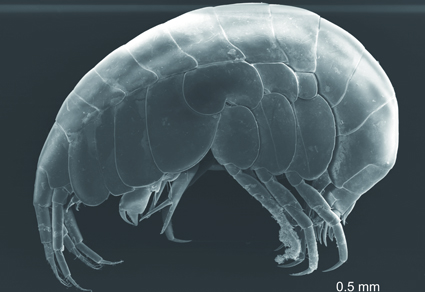Abstract
A new species of sebid amphipod, Seba marianaensis sp. nov., is described from the Shinkai Seep Field, Mariana Trench, at a depth of 5689–5683 m. Seba marianaensis sp. nov. is most similar to Seba bathybia; however, it differs from S. bathybia by the setation of the mandibular palp and uropod 3 ramus and the shape of the gnathopod 1 coxa. This is the first record of Sebidae from the Mariana Trench.
References
- Ariyama, H. (2009) Four species of the genus Seba from Japan, with descriptions of two new species (Crustacea: Amphipoda: Sebidae). Zootaxa, 2159 (1), 44–68. https://doi.org/10.11646/zootaxa.2159.1.2
- Barnard, J.L. & Karaman, G.S. (1991) The families and genera of marine gammaridean Amphipoda (except marine gammaroids). Records of the Australian Museum, Supplement, 13 (Parts 1 and 2), 1–866. https://doi.org/10.3853/j.0812-7387.13.1991.367
- Bate, C.S. (1862) Catalogue of the specimens of amphipodous Crustacea in the collection of the British Museum, London. British Museum of Natural History, London, 399 pp., 58 pls.
- Bell, J.B., Woulds, C. & Oevelen, D.v. (2017) Hydrothermal activity, functional diversity and chemoautotrophy are major drivers of seafloor carbon cycling. Scientific Reports, 7, 12025. https://doi.org/10.1038/s41598-017-12291-w
- Chen, C., Watanabe, H.K. & Ohara, Y. (2018) A very deep Provanna (Gastropoda: Abyssochrysoidea) discovered from the Shinkai Seep Field, Southern Mariana Forearc. Journal of the Marine Biological Association of the United Kingdom, 98 (3), 439–447. https://doi.org/10.1017/S0025315416001648
- Chevreux, E. (1889) Amphipodes nouveaux provenant des campagnes de l’Hirondelle 1887–1888. Bulletin de la Societe zoologique de France, 14, 283–289.
- Larsen, K. (2007) Amphipoda (Crustacea; Peracarida) from the hydrothermal vent system of the Juan de Fuca Ridge, Escabana Trough and Gorda Ridge, Northeast Pacific. Zootaxa, 1445 (1), 1–26. https://doi.org/10.11646/zootaxa.1445.1.1
- McClain, C.R., Allen, A.P., Tittensor, D.P. & Rex, M.A. (2012) Energetics of life on the deep seafloor. Proceedings of the National Academy of Sciences of The United States of America, 109, 15366–15371. https://doi.org/10.1073/pnas.1208976109
- Nation, J.L. (1983) A new method using hexamethyldisilazane for preparation of soft insect tissues for scanning electron microscopy. Stain Technology, 58, 347–351. https://doi.org/10.3109/10520298309066811
- Ohara, Y., Reagan, M.K., Fujikura, K., Watanabe, H., Michibayashi, K., Ishii, T., Stern, R.J., Pujana, I., Martinez, F., Girard, G., Ribeiro, J., Brounce, M., Komori, N. & Kino, M. (2012) A serpentinitehosted ecosystem in the southern Mariana forearc. Proceedings of the National Academy of Sciences of the United States of America, 109 (8), 2831–2835. https://doi.org/10.1073/pnas.1112005109
- Okumura, T., Ohara, Y., Stern, R.J., Yamanaka, T., Onishi, Y., Watanabe, H., Chen, C., Bloomer, S.H., Pujana, I., Sakai, S., Ishii, T. & Takai, K. (2016) Brucite chimney formation and carbonate alteration at the Shinkai Seep Field, a serpentinite‐hosted vent system in the southern Mariana forearc. Geochemistry, Geophysics, Geosystems, 17, 3775–3796. https://doi.org/10.1002/2016GC006449
- Okutani, T., Fujikura, K., Watanabe, H. & Ohara, Y. (2013) Calyptogena (Abyssogena) mariana: discovery of a new vesicomyid clam from the Mariana Trench. Venus [Journal of the Malacological Society of Japan], 71, 39–47. https://doi.org/10.18941/venus.71.1-2_39
- Shaw, P. (1989) New amphipods from geothermal vent sites off the west coast of Vancouver Island, British Columbia, with a reappraisal of the amphipod family Sebidae. Canadian Journal of Zoology, 67, 1882–1890. https://doi.org/10.1139/z89-269
- Tomikawa, K., Watanabe, H.K., Tanaka, K. & Ohara, Y. (2021) A new species of Princaxelia from Shinkai Seep Field, Mariana Trench (Crustacea, Amphipoda, Pardaliscidae). ZooKeys, 1015, 115–127. https://doi.org/10.3897/zookeys.1015.59683
- Tomikawa, K., Watanabe, H.K., Tanaka, K. & Ohara, Y. (2022) Discovery of a new species of Paronesimoides (Crustacea: Amphipoda: Tryphosidae) from a cold seep of Mariana Trench. Journal of Natural History, 56, 463–474. https://doi.org/10.1080/00222933.2022.2074906
- Walker, A.O. (1907) Crustacea. III.—Amphipoda. National Antarctic Expedition, British Museum (Natural History), 3, 1–39, 13 pls.
- Wang, Y., Zhu, C., Sha, Z. & Ren, X. (2019) Description of Seba longimera sp. nov. from hydrothermal vents in the Okinawa Trough, Northwest Pacific (Amphipoda, Amphilochoidea, Sebidae). ZooKeys, 899, 141–149. https://doi.org/10.3897/zookeys.899.39442
- Watanabe, H.K., Chen, C, Nishi, E. & Ohara, Y. (2021) Cryptic diversity of the tube-dwelling polychaete Phyllochaetopterus in the Shinkai Seep Field, Mariana Trench. Plankton and Benthos Research, 16, 73–77. https://doi.org/10.3800/pbr.16.73


